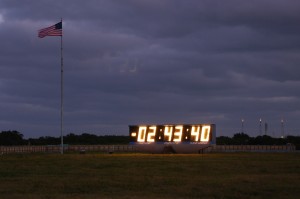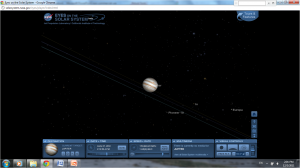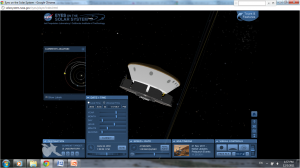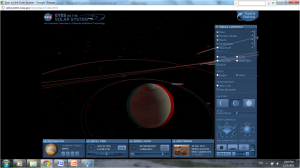If you are using a Windows machine, you can now download a theme for your computer featuring Mars Science Laboratory Curiosity images, courtesy of Windows Observer.com. I don’t usually use themes because I’m too obsessed with my own wallpaper choices, but in this case, I’ll make an exception.
MSL Windows Theme
30 08 2012Comments : Comments Off on MSL Windows Theme
Categories : Mars Science Laboratory
Gale Crater
6 08 2012I’m seeing a steady stream of hits on this site by people searching for maps of Gale Crater. I included a few maps in an earlier post about the MSL launch, but the best collection can be found on the HiRISE site. I recommend in particular the collection gathered during the landing proposal phase of the MSL project. You can also do a search on the words “Gale Crater” or browse through the image catalog to look at the most recent images.
The JPL’s Explore Mars! site includes a tool for exploring Gale Crater. Use the navigation bar at the top of the page or click on any of the topographic tags to zoom and read more about the crater’s features. And of course, you don’t want to overlook Google Mars. Don’t expect to get any work done once you open that page up, though.
Comments : Comments Off on Gale Crater
Categories : Instruments, Mars Science Laboratory, NASA
Wheels Down
6 08 2012You should be impressed. It’s two o’clock in the morning and I’m writing a blog post. Without my glasses. Proof of landing above, more images and explanations to follow tomorrow.
Comments : Comments Off on Wheels Down
Categories : Instruments, Mars Science Laboratory, NASA, News
MSL Raw Images
5 08 2012
This image was taken by Front Hazcam: Left A (FHAZ_LEFT_A) onboard NASA’s Mars rover Curiosity on Sol 0 (2012-08-06 06:23:34 UTC). Image Credit: NASA/JPL-Caltech
Future Mars Science Laboratory raw images will be collected at http://mars.jpl.nasa.gov/msl/multimedia/raw/. Check back for the early images returned by Curiosity!
ETA: Try http://mars.jpl.nasa.gov/msl/multimedia/images/ if the raw images aren’t working in your browser. If you’re using Chrome, try clearing your cache. If you still can’t load the raw images, try IE.
Comments : Comments Off on MSL Raw Images
Categories : Instruments, Mars Science Laboratory, NASA, News
Mars Science Laboratory Link Round Up
1 08 2012News briefings:
- NASA Announcements (follow links on page for updates)
- NASA TV News (check for updated television schedules)
For an overview of the Mars Science Laboratory and Curiosity’s Mission:
- Mars: NASA Explores the Red Planet
- JPL/NASA: Landing Press Kit
- Universe Today: Quick and Curious Facts
Live Computer simulation:
Where to watch the landing:
- NASA TV
- JPL List of Public Events
- NASA Mars Event Map
- Go to Times Square (New York)
- Adler Planetarium (Chicago)
- Cincinnati Observatory Center (Cincinnati)
- Columbia Memorial Space Center (Downey, CA)
- Griffith Observatory (Los Angeles)
Photos:
Videos:
- Curiosity’s Seven Minutes of Terror
- William Shatner and the Grand Entrance
- Wil Wheaton and the Grand Entrance
- Ph.Detours: Curiosity (the New Mars Rover) Explained
- MSL Landing Site: Gale Crater
- Mars in a Minute: How Hard is to Land Curiosity on Mars?
Twitter:
- MSL (Search)
- @NASA (NASA Main Account)
- @NASAJPL (NASA JPL)
- @NASA_EDGE (NASA EDGE)
- @MSL_101 (Mars Curiosity)
- @MarsRoverDriver (Scott Maxwell)
- @MarsCuriosity (Curiosity Rover)
- @MarsScienceGrad (MarsScienceGrad)
- @SpaceflightNow (Spaceflight Now)
- @NASAWatch (NASA Watch)
- @NASA_Eyes (Eyes on the Solar System)
- @elakdwalla (Emily Lakdawalla, Planetary Society blogger)
Comments : Comments Off on Mars Science Laboratory Link Round Up
Categories : Mars Science Laboratory, NASA, News
At the Track: Mars Curiosity
1 08 2012Because we can never have too many Hot Wheels.
Comments : Comments Off on At the Track: Mars Curiosity
Categories : Ephemera, Mars Science Laboratory, News
Wallpaper Wednesday
1 08 2012You didn’t forget about me, did you? I’m about to land on Mars!
Mars Landing: 5-6 August 2012
10:31 pm Pacific, 5 August
11:31 pm Mountain, 5 August
12:31 am Central, 6 August
01:31 am Eastern, 6 August
05:31 am Universal, 6 August
Watch it live online at:
mars.jpl.nasa.gov
nasa.gov (NASA TV)
jpl.nasa.gov (Ustream)
Click on the image to download the JPL MSL wallpaper.
Comments : Comments Off on Wallpaper Wednesday
Categories : Instruments, Mars Science Laboratory, News, Wallpaper
MSL Position
9 01 2012If you hit this page trying to find the current position of the Mars Science Laboratory, click through here to go to NASA-JPL’s Where is Curiosity? page. JPL updates the simulated views of Curiosity’s journey daily.
Comments : Comments Off on MSL Position
Categories : Instruments, Mars Science Laboratory, NASA
#MSL #NASATweetup
2 12 2011I’m still adding photos, but the base set from launch morning can be found on my flickr site.
Comments : 4 Comments »
Categories : Mars Science Laboratory, NASA
Eyes on the Solar System
2 12 2011There are a number of useful observing tools online. For instance, today I used Sky and Telescope’s Transit Times of Jupiter’s Great Red Spot to plan this evening’s observation session. I regularly use Stellarium, a free open source virtual planetarium, to look at the night sky. Similarly, I try to look at Heavens Above at some point during the day so I know when to run outside and look for an interesting satellite flyby. I follow the International Space Station on twitter (@twisst); once a day I get a tweet telling me when and where to look to see the ISS flyover. So far today, I’ve used Sky and Telescope’s This Week’s Sky at a Glance, the Red Spot calculator, Stellarium, and two iPhone apps (Moon and Moon Globe, both free). I also used Mars Globe, but just because I was goofing off—I like to know when daylight strikes Gale Crater, for some reason.
And speaking of goofing off, if you’ve got some time on your hands, I’ve got the website for you. Before last Saturday’s Mars Science Laboratory launch, attendees of the MSL NASATweetup had the opportunity to attend a demonstration of Eyes on the Solar System, JPL’s 2D/3D visualization tool. Populated with NASA mission data, Eyes on the Solar System allows the user to soar and leap through the universe in real time (you’re not limited to real time, though). I’ll be honest: the learning curve is a bit steep, but once you get the hang of the controls, you’ll find yourself zooming from planet to planet, satellite to asteroid. You’ll be playing god, commanding the moons of Jupiter to orbit in double time or more. I’ve currently got them moving at approximately 170, 700, 000 miles per hour, which means I’m forcing them to fly across the distance they would normally travel in 1 hour in the space of a second.
The above screen shot (click on the image to enlarge it in a new window) gives you an idea of the user interface. If you look at the bottom center of the screen, you can see that I’ve sped up the speed of the orbits (170, 065, 241 MPH at the moment I took the screen shot). To the right of that speed designation is a button for re-setting the motion to real time.
Above is a screen shot with all the menus open. You can see some of the pre-set tour options in the left-hand fly-up menu. You can zoom in and study the sun, any of the planets, including the dwarfs, asteroids and comets. But maybe the most exciting option is riding along with some of NASA’s spacecraft. You can configure the program to look over the spacecraft’s “shoulder” or use the SPEED + RATE menu to look ahead in the spacecraft’s predicted trajectory. I’m super happy to say that Mars Science Laboratory data is already being folded into Eyes.
The above image shows a view of the spacecraft as it should look on August 4, 2012. To the left of the spacecraft is a small window showing its current location in the solar system (produced by clicking on the crosshairs icon on the left-most fly-up menu). Just a note–if you’re being blinded by a regular flash of light, you’ve probably zoomed in too close to Mars. Now for the cool stuff. Got your 3D glasses ready? We’re going anaglyph. Zoom to a good view of Mars and its satellites, then click on the top bar of the VISUAL CONTROLS menu, to the right of the screen.
Now, click on the “View in 3D” line under PERFORMANCE on the VISUAL CONTROLS menu. Put on your glasses and you’re good to go.
You’ll just have to imagine a room full of space geeks wearing cardboard 3D glasses during our demonstration on Saturday (or you could do a web search, ’cause I’m sure the photo evidence is out there somewhere).
The entrance page to the Eyes site provides links to a video introduction, which I recommend watching before you starting pointing and clicking (trust me, been there, done that, had to start over). The tutorials are even more helpful. Many thanks to the team behind Eyes on the Solar System, especially JPL Visualization Producer, Doug Ellison (@Doug_Ellison, @NASA_Eyes), who graciously demonstrated Eyes on the Solar System and Eyes on the Earth for us. And thanks to everyone at NASA and JPL for making the MSL NASATweetup happen. Thanks to you, I learned a ton, met some great people, and finally got to attend a rocket launch.
Comments : Comments Off on Eyes on the Solar System
Categories : Instruments, Mars Science Laboratory, NASA











